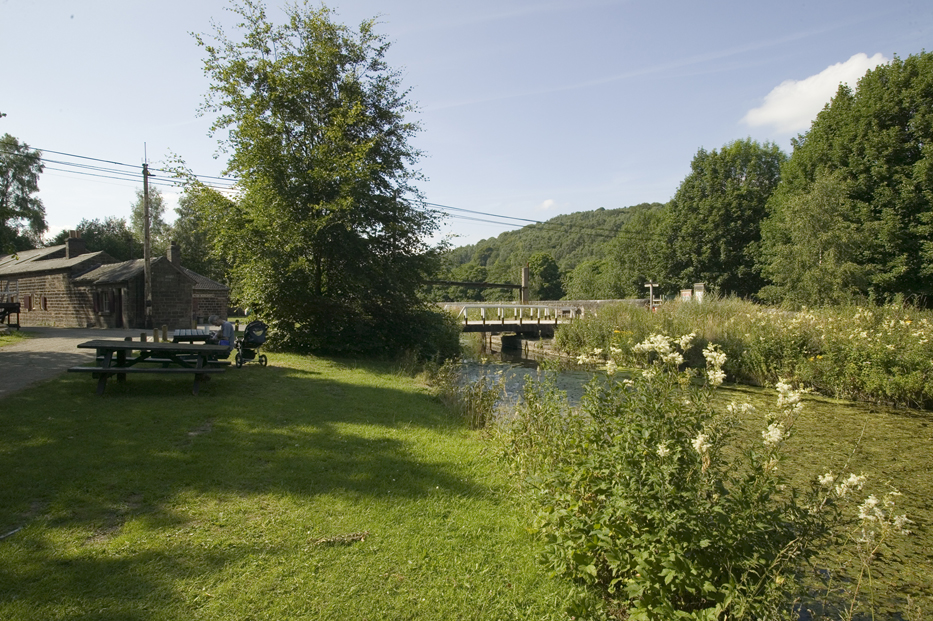Key Sites – The Cromford Canal

Key Sites – The Cromford Canal
The Cromford Canal ran 23.3 kilometres from Cromford to the Erewash Canal at Langley Mill. The 10.5 kilometres of canal between Cromford and Ambergate which lie within the nominated World Heritage Site was constructed in the early 1790s under the direction of William Jessop assisted by Benjamin Outram. The canal was intended as part of a through route to Manchester but it was not until the Cromford and High Peak Railway was constructed between 1824 and 1830 that this vision became a reality.
The Cromford Canal promoters sought to unlock Derbyshire’s immense mineral wealth, especially its limestone. Apart from the obvious advantages to Sir Richard Arkwright for his mills, he too saw the opportunity presented by exporting lime and sought a monopoly in this trade on the canal in return for which he was prepared to lend his name to the promoters of the canal project. Only when he was finally persuaded that such a monopoly would be against the law did he agree to give the canal scheme his energetic attention. He also agreed to sell most of his garden to the Canal Company to construct the Cromford Wharf. With his assistance the Canal Bill was steered through Parliament in the face of considerable opposition.
The canal had a profound influence on the economic growth of central Derbyshire achieving a substantial outreach by means of its many wharves and linking tramroads. Thus Belper, apparently bypassed by the canal, derived huge economic benefits from it.
The canal terminus abuts Mill Lane opposite Cromford Mill. Cromford Wharf incorporates two warehouses, an office or counting house and two cottages. Once enclosed entirely by a stone perimeter wall, the wharf was home to a range of other facilities; these buildings have not survived.
The Cromford Canal Wharf
Canal Warehouse (1794 – Listed Grade II)
The warehouse was built soon after the canal opened for Nathaniel Wheatcroft, who was to become the principal canal carrier.
It is built of coursed, squared and dressed sand-stone with two storeys and half basement and is roofed in graduated Welsh slate. The elevation visible from Willersley Castle has an embattled parapet and this feature has led to the structure being known locally as ‘the gothic warehouse’. It was used to receive goods brought in by the canal boats and awaiting onward transport. The lean-to shed over the canal was added in 1814. The building has been restored by the Arkwright Society.
Warehouse (c.1824 – Listed Grade II)
A two-storey, three-bay, warehouse in coursed dressed sandstone, with a slate-hung cantilevered projection overhanging the feeder arm of the canal. It was built soon after the feeder arm was added. It was used to store goods awaiting transport by boat which, thanks to the overhanging section of the building, could be loaded under cover. The warehouse was equipped with a crane, now replaced by a modern replica. The building was out of use for many years and following restoration by the Arkwright Society is now a canalside restaurant.
The Counting House Part (c.1794: part late 19th century – Listed Grade II)
A two-storey polygonal structure in coursed dressed sandstone with a Welsh slate roof. Its unusual shape is explained by its proximity to the culvert which brought water to the canal from the Cromford Mill basin and by the limited space between this and the canal wharf gates, of which the two massive stone posts have survived.
The building was restored by the Arkwright Society, which uses it as an office.
Two canal cottages built for the Cromford Canal Company soon after the canal opened and later extended to accommodate company administrative staff. One of the cottages has been carefully restored and has regained its original appearance.
Copyright
The Cromford Canal Wharf – with illustrations (pdf)
The Cromford Canal: features south of Cromford Wharf
Accommodation Bridge (c.1792 – Unlisted)
South of Cromford Wharf the coursed stone accommodation bridge with a string course and parapet, believed to have been built c.1792. There are others of similar design along the line of the canal. A notable feature of this bridge is the evidence in the stonework of wear caused by the canal boat tow ropes.
High Peak Junction
The Cromford and High Peak Railway which opened in 1830, completed the link to the Manchester area the canal promoters had intended to provide. It crossed the high ground between Cromford and Whaley Bridge by means of a series of inclines and stationary steam engines. These were linked by level sections on which the wagons were hauled by horses. The junction was created to provide a link for trans-shipping goods between the Cromford and High Peak Railway and the canal. A later link connected the junction to the railway between Ambergate and Matlock.
On the west side of the canal there are several buildings which served the needs of the railway and most notably the railway workshops. This group of buildings was built, re-built and enlarged between c.1830 and c.1865. In the first instance the workshop served the needs of the inclined plane railway and horse-drawn wagons. Later when steam locomotives were introduced to the line the workshop’s functions were extended. The buildings are of coursed gritstone and brick. Inside the building there are surviving examples of the original fish-bellied cast iron rails used on the Cromford and High Peak Railway. The workshop houses a small museum which is open to the public during the summer months.
Warehouse (c.1850 – Unlisted)
The warehouse which stands between the canal and the railway was built c.1850 to replace an earlier canal building. It is now used as a residential study centre. It is built of coursed stone and has a covered canopy under which railway goods would have been loaded to protect them from the weather. It also has a load height gauge for the railway. Adjacent to the warehouse is a larger open shed supported by cast iron columns. Adjacent on the north side are the remains of the base of a crane.
To the south is a building of c.1850 in coursed stone which was used as railway offices. Further south on the canal is a paved spillway over which surplus water was discharged from the canal into the river.
The Leawood Pumphouse (1849 – Listed Grade II* and a Scheduled Ancient Monument)
The Leawood pumphouse, engine and chimney, are situated south of High Peak Junction and on the east side of the canal.
These structures were built in 1849 to house a steam pumping engine to increase the supply of water available to the canal. The pedimented pumphouse building is of ashlar gritstone with chamfered quoins. It has a square-headed doorway with pilasters and quoined round-arch windows. The adjacent boiler house has arched doorways. The engine was constructed at the Milton Ironworks by Graham & Co. It is a Boulton and Watt single action beam engine which is maintained in operational condition and is put in steam from time to time.
Watch a video about Leawood Pumphouse
The Pumphouse Chimney
The 29 metres high engine chimney is built of coursed stone and has a cast iron parapet.
The Cromford Canal: features south of Cromford Wharf – with illustrations (pdf)

